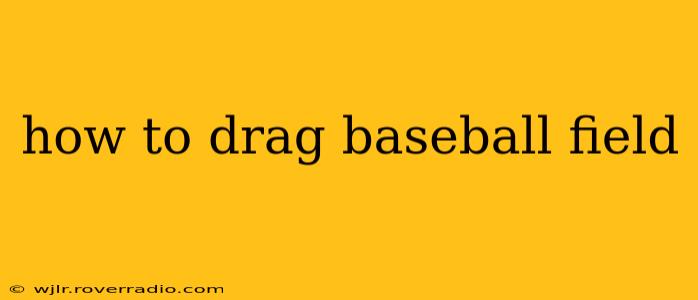How to Drag a Baseball Field: A Comprehensive Guide for Maintaining a Pristine Playing Surface
Maintaining a well-maintained baseball field requires consistent effort, and dragging—or grooming—the infield is a crucial part of that process. This process isn't just about aesthetics; it directly impacts the quality of play, ensuring a safe and consistent playing surface for athletes. This guide will cover various aspects of dragging a baseball field, from the tools required to the different techniques employed by groundskeepers.
What is dragging and why is it important?
Dragging, also known as grooming or brushing, is the process of using specialized equipment to smooth and level the infield dirt. This is essential for several reasons:
- Level playing surface: Dragging creates a consistent playing surface, ensuring fair bounces and preventing uneven terrain from affecting gameplay.
- Improved drainage: By leveling the infield, you improve drainage, preventing puddles and soggy areas that can disrupt the game.
- Enhanced playability: A well-dragged infield ensures consistent ball movement, making it easier for players to field ground balls and make plays.
- Preventing ruts and holes: Regular dragging prevents the formation of ruts and holes in the infield dirt, maintaining its integrity.
- Weed control: Dragging can help to disrupt weed growth, keeping the field looking neat and tidy.
What tools do I need to drag a baseball field?
The tools you'll need depend on the size of your field and the type of infield mix. However, some essential equipment includes:
- Drag mat: This is the primary tool used for dragging. Different types exist (e.g., steel, aluminum, or plastic) offering various levels of aggressiveness. Choosing the right mat depends on the soil conditions and the level of maintenance required.
- Drag harrow: Used for more significant leveling tasks, the harrow breaks up clumps of dirt and distributes the infield mix evenly. It's particularly helpful after heavy rainfall or significant wear and tear.
- Water source: Consistent moisture is key to proper dragging. A hose or sprinkler system is necessary to keep the infield moist during and after dragging.
- Rake: A landscape rake helps to remove debris and smooth out any uneven areas before or after dragging.
- Infield mix: To maintain a consistent infield, you will likely need to add infield mix periodically. This replaces material lost due to play and erosion.
What are the different techniques for dragging a baseball field?
The method you use will depend on the condition of the field and the tools available. Here are some common techniques:
- Straight dragging: This involves dragging the mat in straight lines across the infield, overlapping each pass to ensure even coverage.
- Diagonal dragging: Dragging diagonally helps to break up any developing ruts or compacted areas.
- Circular dragging: This method can be used in targeted areas to address specific problems, such as a particularly bumpy spot.
- Harrowing: The harrow is used before dragging to break up clumps and level out larger imperfections. This is often done after significant rain or intensive use.
How often should I drag a baseball field?
The frequency of dragging depends on several factors, including weather conditions, the intensity of use, and the type of infield mix. Generally, you should drag the infield after each game and at least once a week, adjusting this schedule based on the conditions. After significant rain, you might need to drag multiple times to restore the playing surface.
What type of soil is best for a baseball field?
The ideal infield mix is a blend of clay, sand, and silt, specifically designed to provide excellent drainage, consistent playability, and resistance to compaction. This mix allows for a firm base that won't develop significant ruts or holes under pressure.
How do I maintain the proper moisture level in the infield?
Maintaining proper moisture is crucial. Too dry, and the infield becomes dusty and unplayable. Too wet, and it becomes muddy and unusable. The goal is to maintain a consistency that allows for smooth play but also proper drainage. Regular watering and monitoring of the infield are key.
By following these guidelines, you can effectively drag your baseball field, ensuring a safe, consistent, and enjoyable playing experience for all. Remember, regular maintenance is key to keeping your field in top condition.
